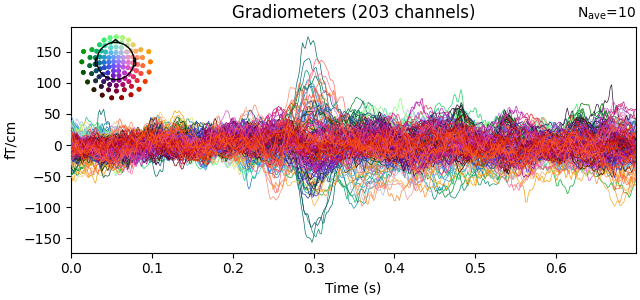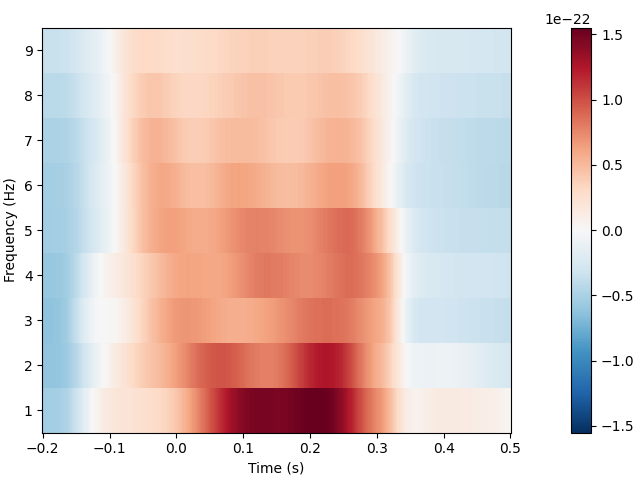Note
Go to the end to download the full example code.
Epoching a Stream in real-time🔗
The EpochsStream object can be used similarly to
mne.Epochs to create epochs from a continuous stream of samples around events
of interest.
Note
The EpochsStream object is designed to work with
any Stream object. At the time of writing, only
StreamLSL is available, but any object inheriting from the
abstract BaseStream object should work.
A EpochsStream object support peak-to-peak rejection, baseline
correction and detrending.
Event source🔗
A EpochsStream object requires an event source to create
epochs. 3 event sources are supported:
a set of
'stim'channels within the attachedStreamobject.a set of
'stim'channels within a separateStreamobject.an irregularly sampled
Streamobject.
Note
In the case of an irregularly sampled Stream object, only numerical streams are
supported at the moment because interaction with str streams in Python is not
as performant as interaction with numerical streams.
Set of 'stim' channels🔗
The set of 'stim' channels from which the events are extracted can be either part
of the regularly sampled Stream object epoched (argument stream) or part of a
separate regularly sampled Stream object (argument event_stream). In both case,
the channel(s) type should be 'stim' and the channel(s) should be formatted for
mne.find_events() to correctly extract the events. The channels to consider are
provided in the argument event_channels and the events to consider in the argument
event_id. Let’s create epochs around the event ID 2 from the 'STI 014'
channel of MNE’s sample dataset.
import time
import uuid
import numpy as np
from matplotlib import pyplot as plt
from mne import Epochs, EpochsArray, annotations_from_events, find_events
from mne.io import read_raw_fif
from mne_lsl.datasets import sample
from mne_lsl.lsl import resolve_streams
from mne_lsl.player import PlayerLSL
from mne_lsl.stream import EpochsStream, StreamLSL
fname = sample.data_path() / "mne-sample" / "sample_audvis_raw.fif"
raw = read_raw_fif(fname, preload=False).pick(("meg", "stim")).load_data()
source_id = uuid.uuid4().hex
player = PlayerLSL(
raw,
chunk_size=200,
name="tutorial-epochs-1",
source_id=source_id,
annotations=False,
).start()
player.info
Note
A chunk_size of 200 samples is used here to ensure stability and reliability
while building the documentation on the CI. In practice, a chunk_size of 200
samples is too large to represent a real-time application.
In the cell above, a mock LSL stream is created using the 'meg' and 'stim'
channels of MNE’s sample dataset. Now, we need to create a
StreamLSL object connected to this mock LSL stream. The
channel "MEG 2443" is marked as bad and the signal is filtered with a low-pass
filter.
stream = StreamLSL(bufsize=4, name="tutorial-epochs-1", source_id=source_id)
stream.connect(acquisition_delay=0.1, processing_flags="all")
stream.info["bads"] = ["MEG 2443"] # remove bad channel
stream.filter(None, 40, picks="grad") # filter signal
stream.info
Now, we can create epochs using this stream as source for both the epochs and the
events. The 'stim' channel 'STI 014' is used to extract the events and epochs
are created around the event ID 2 using the gradiometer channels. The epochs are
created around the event, from 200 ms before the event to 500 ms after the event. A
baseline correction is applied using the 200 first ms of the epoch as baseline.
epochs = EpochsStream(
stream,
bufsize=20, # number of epoch held in the buffer
event_id=2,
event_channels="STI 014",
tmin=-0.2,
tmax=0.5,
baseline=(None, 0),
picks="grad",
).connect(acquisition_delay=0.1)
epochs.info
Note the bufsize argument in the cell above. This argument controls the number of
epochs that are kept in memory. The actual size of the underlying numpy array depends
on the number of epochs, the number of samples (controlled by tmin and tmax)
and the number of channels.
Let’s wait for a couple of epochs to enter in the buffer, and then let’s convert the
array to an MNE-Python Epochs object and plot the evoked response.
while epochs.n_new_epochs < 10:
time.sleep(0.5)
data = epochs.get_data(n_epochs=epochs.n_new_epochs)
epochs_mne = EpochsArray(data, epochs.info, verbose="WARNING")
epochs_mne.average().plot()
plt.show()

<Player: tutorial-epochs-1 | OFF | /home/runner/mne_data/MNE-LSL-data/sample/mne-sample/sample_audvis_raw.fif>
Irregularly sampled stream🔗
The event source can also be an irregularly sampled stream. In this case, we have 2 modes of operation:
event_idisNone: in this case, each channel represents a separate event. A new value entering the buffer of a channel is interpreted as an event, regardless of the value itself. For instance, this is useful for irregularly sampled numerical stream using aPlayerLSLwith aRawobject which hasAnnotationsattached to it.event_idis notNone: in this case, the event stream is expected to have only one channel with a numerical value at a time. The value is interpreted as the event code.
The example below shows how to use the first mode of operation.
events = find_events(raw, stim_channel="STI 014")
events = events[np.isin(events[:, 2], (1, 2))] # keep only events with ID 1 and 2
annotations = annotations_from_events(
events,
raw.info["sfreq"],
event_desc={1: "ignore", 2: "event"},
first_samp=raw.first_samp,
)
annotations.duration += 0.1 # set duration since annotations_from_events sets it to 0
annotations
<Annotations | 143 segments: event (72), ignore (71)>
raw.set_annotations(annotations)
player = PlayerLSL(
raw, chunk_size=200, name="tutorial-epochs-2", source_id=source_id, annotations=True
).start()
player.info
We now have 2 LSL stream availables on the network, one of which is an irregularly sampled numerical streams of events.
[< sInfo 'tutorial-epochs-2-annotations' >
| Type: annotations
| Sampling: Irregular
| Number of channels: 2
| Data type: <class 'numpy.float64'>
| Source: 1eb4246c69b64a31afd840d670d14b98
, < sInfo 'tutorial-epochs-2' >
| Sampling: 600.614990234375 Hz
| Number of channels: 315
| Data type: <class 'numpy.float64'>
| Source: 1eb4246c69b64a31afd840d670d14b98
]
We can now create a StreamLSL object for each available
stream on the network.
stream = StreamLSL(bufsize=4, name="tutorial-epochs-2", source_id=source_id)
stream.connect(acquisition_delay=0.1, processing_flags="all")
stream.info["bads"] = ["MEG 2443"] # remove bad channel
stream.filter(None, 40, picks="grad") # filter signal
stream.info
stream_events = StreamLSL(
bufsize=20, name="tutorial-epochs-2-annotations", source_id=source_id
)
stream_events.connect(acquisition_delay=0.1, processing_flags="all")
stream_events.info
Let’s first inspect the event stream once a couple of samples have been acquired.
while stream_events.n_new_samples < 3:
time.sleep(0.5)
data, ts = stream_events.get_data(winsize=stream_events.n_new_samples)
print("Array of shape (n_channels, n_samples): ", data.shape)
data
Array of shape (n_channels, n_samples): (2, 3)
array([[0.1, 0. , 0.1],
[0. , 0.1, 0. ]])
Each channel corresponds to a given annotation, 0 to 'ignore' and 1 to
'event'. The value is 0 when no annotation is present, and x when an
annotation is present, with x being the duration of the annotation.
Thus, this array can be interpreted as follows:
array([[0.1, 0. , 0.1],
[0. , 0.1, 0. ]])
An annotation of 0.1 seconds labelled
'ignore'was received atts[0].An annotation of 0.1 seconds labelled
'event'was received atts[1].An annotation of 0.1 seconds labelled
'ignore'was received atts[2].
We can now use those 2 streams to create epochs around the events of interest.
epochs = EpochsStream(
stream,
bufsize=20, # number of epoch held in the buffer
event_id=None,
event_channels="event", # this argument now selects the events of interest
event_stream=stream_events,
tmin=-0.2,
tmax=0.5,
baseline=(None, 0),
picks="grad",
).connect(acquisition_delay=0.1)
epochs.info
Let’s wait for a couple of epochs to enter in the buffer, and then let’s convert the
array to an MNE-Python Epochs object and plot the time-frequency
representation of the evoked response.
while epochs.n_new_epochs < 10:
time.sleep(0.5)
data = epochs.get_data(n_epochs=epochs.n_new_epochs)
epochs_mne = EpochsArray(data, epochs.info, tmin=-0.2, verbose="WARNING")
freqs = np.arange(1, 10)
tfr = epochs_mne.average().compute_tfr(
method="multitaper", freqs=freqs, n_cycles=freqs / 2
)
tfr.plot(baseline=(None, 0), combine="mean")
plt.show()

Let’s compare this to a Epochs object created from the same number of
events offline.
Note
The same epochs were not selected between the offline and online processing.
epochs_offline = Epochs(
raw, events, event_id=dict(event=2), baseline=(None, 0), picks="grad", preload=True
)
epochs_offline.filter(None, 40)
tfr = epochs_offline.average().compute_tfr(
method="multitaper", freqs=freqs, n_cycles=freqs / 2
)
tfr.plot(baseline=(None, 0), combine="mean")
plt.show()

Finally, in this case a single event was kept in the
EpochsStream, but if more events are retained, it is
important to know which one is which. This information is stored in the property
events of the
EpochsStream, which is an internal buffer of the event codes.
array([0, 0, 0, 0, 0, 0, 0, 0, 0, 0, 0, 0, 0, 0, 0, 0, 0, 0, 0, 0],
dtype=int16)
Note
In the case of an irregularly sampled event stream, the event code represents the channel idx within the event stream.
Free resources🔗
When you are done with a PlayerLSL, a
StreamLSL or a EpochsStream don’t
forget to free the resources they use to continuously mock an LSL stream or
receive new data from an LSL stream.
<EpochsStream OFF (n: 20 between (-0.2, 0.5 seconds)> connected to:
<Stream: ON | tutorial-epochs-2 (source: 1eb4246c69b64a31afd840d670d14b98)>
<Stream: OFF | tutorial-epochs-2 (source: 1eb4246c69b64a31afd840d670d14b98)>
<Stream: OFF | tutorial-epochs-2-annotations (source: 1eb4246c69b64a31afd840d670d14b98)>
<Player: tutorial-epochs-2 | OFF | /home/runner/mne_data/MNE-LSL-data/sample/mne-sample/sample_audvis_raw.fif>
Total running time of the script: (0 minutes 52.076 seconds)
Estimated memory usage: 707 MB